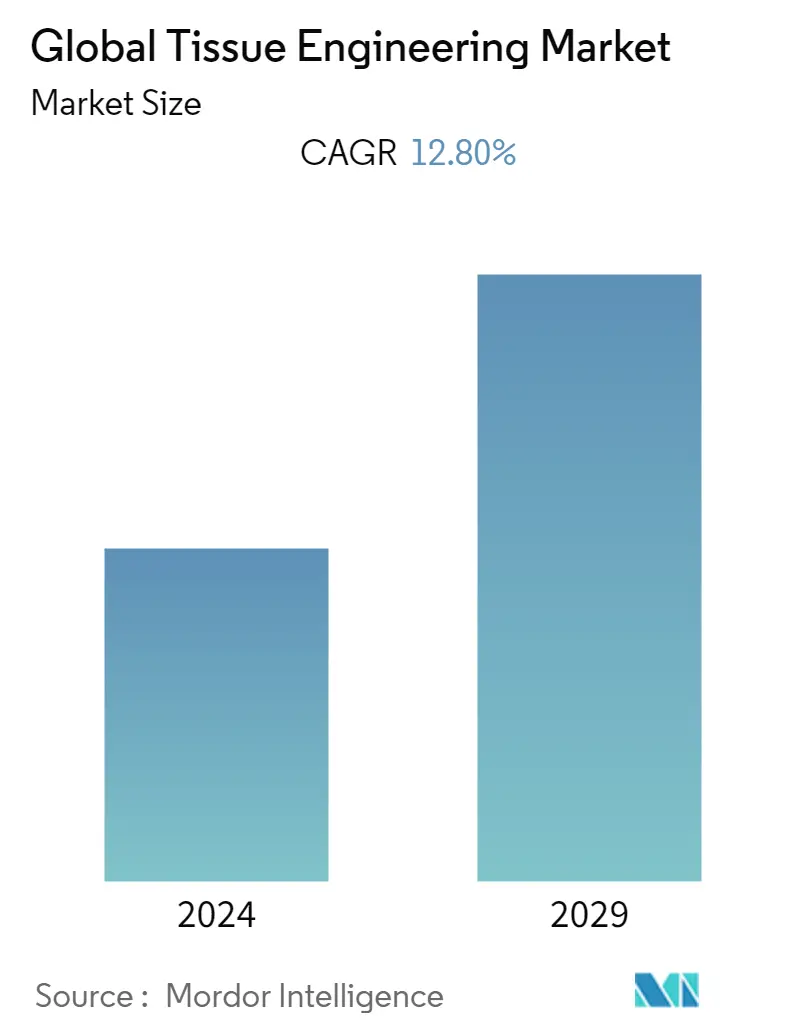Market Size of Global Tissue Engineering Industry

| Study Period | 2019 - 2029 |
| Base Year For Estimation | 2023 |
| CAGR | 12.80 % |
| Fastest Growing Market | Asia-Pacific |
| Largest Market | North America |
| Market Concentration | Low |
Major Players
*Disclaimer: Major Players sorted in no particular order |
Tissue Engineering Market Analysis
The tissue engineering market is expected to register a CAGR of nearly 12.8% during the forecast period (2022-2027).
There have been effects of the COVID-19 pandemic on different surgical techniques. As a result of the lockdown restrictions, individuals with various lifestyle-related and chronic conditions had a delay in diagnosis and treatments, which affected the market under study. As per a study published in March 2021 entitled "Combating COVID-19 with tissue engineering: a review" after COVID-19, the lungs may sustain significant damage, particularly as a result of cytokine overexpression. Mesenchymal stem cells (MSCs) can repair injured lung tissue, stabilize endothelial fluid leaks, and decrease the alveolar-capillary barrier function, which helps to prevent the formation of interstitial lung edema. Since COVID-19 causes significant organ damage, tissue engineering plays a significant role in repairing lung tissue that has been destroyed. However, the market under study is anticipated to return to its full potential over time due to continued immunizations and a decline in COVID-19 cases.
Globally, there has been an increasing incidence of chronic diseases such as orthopedic, cardiovascular, and neurology disorders, which are leading to disability and negatively impacting people's physical and mental well-being. According to the study titled 'Sexuality and relationship experiences of women with spinal cord injury: reflections from an Indian context' published in the Sexual and Reproductive Health Matter in May 2022, around 250,000-500,000 persons worldwide suffer a spinal cord injury (SCI) each year. The most frequent causes of SCI include falls, violent acts, and traffic injuries. Men sustain these injuries at a rate of about 80%. Thus, chronic diseases are the leading causes of death and disability worldwide, which is expected to drive the market growth over the forecast period.
The rising chronic diseases, road accidents, and trauma injuries are found to be contributing to the growth in the development of tissue engineering solutions. There is an increasing number of people in need of bone implants that are on the rise owing to the increasing cases of chronic diseases, trauma cases, and growing average life span. According to the World Health Organization (WHO) Report 2021, each year 20-50 million people suffer from non-fatal injuries, with many incurring a disability as a result of their injury. 93% of the world's fatalities on the roads occur in low and middle-income countries, even though these countries have approximately 60% of the world's vehicles. Even within high-income countries, individuals from lower socioeconomic backgrounds are more likely to be involved in road traffic crashes. Thus, increasing road traffic-related crashes result in injuries, which is expected to boost the market growth.
Though the procedures are quite promising for the treatment of various conditions involving tissue damage; the high cost associated with these procedures is one of the major factors limiting their adoption among patients.
Tissue Engineering Industry Segmentation
As per the scope of the report, tissue engineering is the use of a combination of cells, engineering, and other materials methods, and suitable biochemical and physicochemical factors to improve or replace the biological tissues. It is gaining traction in various areas such as wound care, burn treatment, orthopedics, neurology, urological products, and others. It also plays an important role in the management of pediatric patients. The Tissue Engineering Market is segmented by Material (Synthetic Materials, Biologically Derived Materials and Others), Application (Orthopedics, Musculoskeletal & Spine, Neurology, Cardiology & Vascular, Skin & Integumentary, Others) and Geography (North America, Europe, Asia Pacific, Middle East and Africa, and South America). The market report also covers the estimated market sizes and trends for 17 different countries across major regions, globally. The report offers the value (in USD million) for the above segments.
| By Material | |
| Synthetic Materials | |
| Biologically Derived Materials | |
| Others |
| By Application | |
| Orthopedics | |
| Musculoskeletal & Spine | |
| Neurology | |
| Cardiology & Vascular | |
| Skin & Integumentary | |
| Others |
| Geography | ||||||||
| ||||||||
| ||||||||
| ||||||||
| ||||||||
|
Global Tissue Engineering Market Size Summary
The tissue engineering market is poised for significant growth, driven by the increasing prevalence of chronic diseases such as orthopedic, cardiovascular, and neurological disorders. These conditions, often resulting in disability, are propelling the demand for advanced tissue engineering solutions. The market is also experiencing a surge due to the rising incidence of road accidents and trauma injuries, which necessitate the development of bone implants and other regenerative therapies. Despite the promising potential of tissue engineering procedures, the high costs associated with these treatments remain a barrier to widespread adoption. However, ongoing advancements in technology and the introduction of innovative products are expected to enhance market penetration and acceptance.
In the United States, the tissue engineering market is experiencing robust growth, fueled by technological advancements in 3D tissue engineering and the presence of key industry players. The increasing incidence of chronic diseases, coupled with an aging population, is driving the demand for tissue engineering therapies. The market is further bolstered by frequent product launches and strategic initiatives such as mergers and acquisitions by leading companies. These developments are not only expanding the product portfolio but also enhancing the market's competitive landscape. As a result, the tissue engineering market is anticipated to witness substantial growth, supported by both regional and global trends in healthcare and technology.
Global Tissue Engineering Market Size - Table of Contents
-
1. MARKET DYNAMICS
-
1.1 Market Overview
-
1.2 Market Drivers
-
1.2.1 Increase Incidences of Chronic Diseases, Road Accidents, and Trauma Injuries
-
1.2.2 Technological Advancements in 3D Tissue Engineering
-
1.2.3 Increase in Funding and Research for Tissue Regeneration
-
-
1.3 Market Restraints
-
1.3.1 High Cost of Treatments Related to Tissue Engineering
-
1.3.2 Lack of Awareness Regarding Tissue Engineering
-
-
1.4 Porter's Five Force Analysis
-
1.4.1 Threat of New Entrants
-
1.4.2 Bargaining Power of Buyers/Consumers
-
1.4.3 Bargaining Power of Suppliers
-
1.4.4 Threat of Substitute Products
-
1.4.5 Intensity of Competitive Rivalry
-
-
-
2. MARKET SEGMENTATION (Market Size by Value - USD Million)
-
2.1 By Material
-
2.1.1 Synthetic Materials
-
2.1.2 Biologically Derived Materials
-
2.1.3 Others
-
-
2.2 By Application
-
2.2.1 Orthopedics
-
2.2.2 Musculoskeletal & Spine
-
2.2.3 Neurology
-
2.2.4 Cardiology & Vascular
-
2.2.5 Skin & Integumentary
-
2.2.6 Others
-
-
2.3 Geography
-
2.3.1 North America
-
2.3.1.1 United States
-
2.3.1.2 Canada
-
2.3.1.3 Mexico
-
-
2.3.2 Europe
-
2.3.2.1 Germany
-
2.3.2.2 United Kingdom
-
2.3.2.3 France
-
2.3.2.4 Italy
-
2.3.2.5 Spain
-
2.3.2.6 Rest of Europe
-
-
2.3.3 Asia Pacific
-
2.3.3.1 China
-
2.3.3.2 Japan
-
2.3.3.3 India
-
2.3.3.4 Australia
-
2.3.3.5 South Korea
-
2.3.3.6 Rest of Asia-Pacific
-
-
2.3.4 Middle East and Africa
-
2.3.4.1 GCC
-
2.3.4.2 South Africa
-
2.3.4.3 Rest of Middle East and Africa
-
-
2.3.5 South America
-
2.3.5.1 Brazil
-
2.3.5.2 Argentina
-
2.3.5.3 Rest of South America
-
-
-
Global Tissue Engineering Market Size FAQs
What is the current Global Tissue Engineering Market size?
The Global Tissue Engineering Market is projected to register a CAGR of 12.80% during the forecast period (2024-2029)
Who are the key players in Global Tissue Engineering Market?
Zimmer Biomet, B. Braun Melsungen AG, Integra Lifesciences, AbbVie (Allergan) and Becton, Dickinson and Company (C.R. Bard) are the major companies operating in the Global Tissue Engineering Market.

